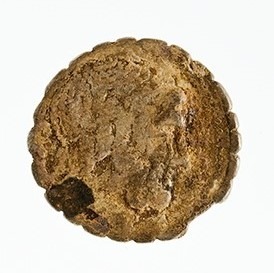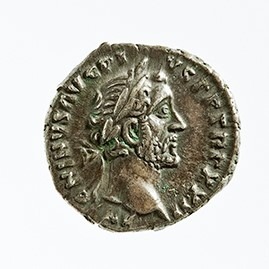Roman Coins

About this Cluster
Roman Coins
The early Republic did not use coinage but a system of bronze weights (aes rude). Early Roman coinage dates from around 300 BC. It appears to have had four main elements each developed independently: bronze currency bars, large cast bronze coins (known as aes grave) and struck silver and bronze coins.
The production of currency bars (sometimes called aes signatum) appears to have ceased by the end of the First Punic War (they should not be confused with the much earlier Ramo Secco bars found in Etruria and Sicily). The standardized currency of cast bronze (aes grave) was based on the denomination of the as, which weighed one pound; the double as was the dupondius. A very small early coin was the semuncia (= a half ounce, that is, 1/24 of an as). In the later part of the third century BC the weight of the as was gradually reduced. These heavy cast coins continued to be issued until Rome’s financial crisis in the Second Punic War.
The struck silver and bronze coins were modelled on the coinage of Magna Graecia, and were probably produced in Naples about 325-285 BC. They circulated in Campania and further south. The earliest of these struck issues are now thought to predate the currency bars and cast bronzes.
In the Second Punic War the Romans came under severe financial stress. There was a reduction of the weight of the silver and aes grave, then debasement of the silver. Finally coin production ceased. In 212 BC, or slightly later, a new coin, the silver denarius, appeared. The first silver denarii were struck in high grade silver and with a weight of c. 4.3 gms. They were the equivalent of ten asses. The most common division of the denarius was the silver sestertius, equivalent to 2½ asses. The denarius itself became Rome’s most important currency unit and lasted into the mid third century AD. The last denarii were somewhat debased and weighed 2.0 – 2.5 gms – a very low rate of inflation over 450 years.
The Roman gold coin, the aureus, was worth 25 denarii. From the beginning of the imperial period the sestertius was minted in orichalcum, ‘brass’, an alloy of copper and zinc with a distinctive golden hue. The dupondius was also of orichalcum, while the as was of copper.
A new coin, the antoninianus, was introduced by Caracalla c. AD 214. It was probably intended as a two-denarius piece. In the mid-third century the antoninianus became very common and almost displaced the denarius. The emperor’s portrait on the antoninianus was always ‘radiate’, that is, rays or beams emanated from the head. This had previously been used mainly to indicate divinity (but Nero used it for his dupondius portraits).
Towards the end of the Republic in 31 BC, there was a growing cult of the individual on the coinage. Over a period of about 50 years the iconography of the denarius evolved gradually from stylized representations of Roma on the obverse of the coin to a self-promoting cult of individuals and their families. Under the Empire the coinage regularly displayed the portrait and attributes of the ruler, or his family members.
Some early coins were produced by casting, that is, by pouring molten metal into a mould. But all the coins in this collection were produced by striking. Usually the lower (obverse) die was fixed, the coin flan was placed above this, and the upper (reverse) die was brought down on the flan by the blow of a hammer (or other instrument).
The obverse (or ‘head’) was the more important, identifying side. On the reverse (or ‘tail’) a greater variety of types was possible. The ‘type’ is the figure or other illustration on the face of a coin. The ‘legend’ is the inscription or wording. This was usually around the edge of a coin, but other common places were the ‘field’ (the central area not occupied by the type) and the exergue (a space at the bottom of a coin).
Mint-marks (letter, monograms, or symbols) were sometimes added, in the Republican period, to indicate who was responsible for the coinage. They rarely state where the mint was, though this can usually be deduced. In the Roman imperial period, the mints were divided into officinae, or workshops, and the mint-mark usually identifies which workshop was responsible for the coin. Stylistic differences suggest that each officina had its own staff of artists and craftsmen. For the coins in this collection the place of minting is Rome unless otherwise stated.
‘Serrate’ coins, that is, coins with notched edges, were issued by the Romans from their earliest coinage until the mid-sixties BC, but the main series did not start until 118 BC. The purpose of the serrations is not certain. They were not to prove the purity of the metal, since several plated serrati are known. Nor were they to prevent the edges being clipped (like modern milling), since clipped coins are virtually unknown from the Republic. Transalpine peoples were familiar with notched wheel amulets as currency: so serrated coinage may have made Roman coinage more readily acceptable in those areas. But serrated coins were not confined to these areas. The technique may have been no more than a casual decorative option, but the vogue for serration contributes to artistic continuity between pre-Sullan and post-Sullan coinage. The notches were cut by hand, with a chisel, before the coin was struck.
It is difficult to give meaningful modern equivalents for ancient sums of money. The following details give some idea of what various denominations meant in ancient Greek and Roman societies.
120 denarii represented the annual pay of Sulla’s Roman troops in 84 BC. By the middle of the first century AD this had risen to 225 denarii, and towards the end of the century Domitian increased it to 300. A free unskilled labourer at Rome might earn 250 denarii a year.
Sulla paid an annual rent of 3000 sesterces for a modest flat in the early first century BC. Cicero’s villa and property at Formiae were valued at 250000 sesterces in 57 BC. His townhouse on the Palatine in Rome was valued at nearly ten times this amount.
A highly skilled slave (surgeon or oculist) in the early imperial period in Italy paid 50000 sesterces for his freedom. Ordinary slaves were valued much less than this. Extraordinary ones were valued more highly.
From the time of Augustus (late first century BC) the minimum financial qualification for a Roman senator was one million sesterces; for an equestrian 400000.
(For these figures, see D. Stockton, Thirty-five Letters of Cicero (Oxford, 1969), Appendix 2.
Some notes on the descriptions of the coins:
r., l., indicate the direction of the type form the viewer’s standpoint.
incuse: opposite to relief design; that is, the type is sunk into the coin flan rather than being raised above it.
The actual legend on a coin is given in capital letters. Abbreviations are filled out by lower-case letters within round brackets. Letters within square brackets are thought to have been originally on the coin but are not now visible (usually because of wear or damage). Letters with dots beneath them are difficult to identify and the reading is thus uncertain.
Authors
Hugh Preston and Beryl Rawson.
Note: Beryl Rawson wrote the majority of the texts on Roman coins. After her death Hugh Preston, Robyn Holt, Susan Chessell, Fred Lomas, and Julia Rymer worked to bring the bibliographies for these entries up to date.
Bibliography
W.E. Metcalf, The Oxford Handbook of Greek and Roman Coinage, Oxford, Oxford University Press, 2012.
A. Burnett, Coinage in the Roman World, London, Seaby, 1987.












